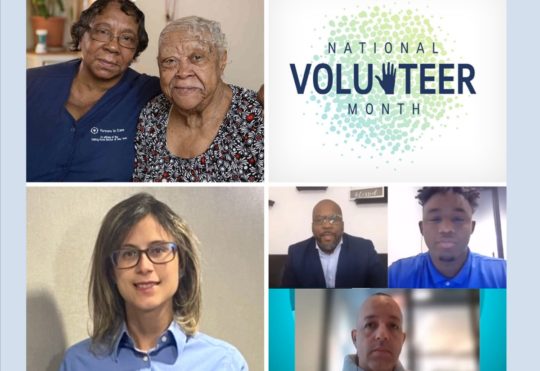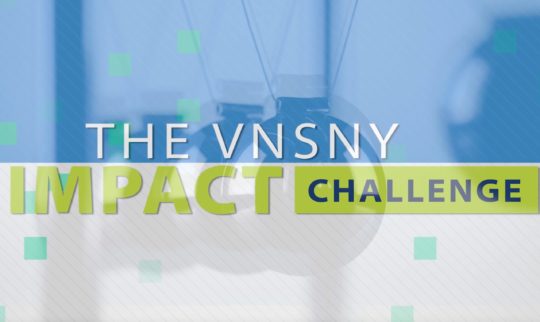Meet VNSNY’s New Green Belts — The Graduates of Our First-Ever Lean Six Sigma Course
From Reducing Hospitalizations to Creating a Roadmap to 4 Stars, VNSNY’s Green Belt Grads Focused on Improving Patient Care
 Lean Six Sigma may sound like a college fraternity, but it’s actually a set of management tools used by organizations worldwide to help them operate more efficiently and improve the quality of their services or products. Tony Dawson, Vice President of Quality and Customer Experience, launched VNSNY’s first Lean Six Sigma program last year, leading 20 staff members through a six-month course that prepared them to become certified Lean Six Sigma Green Belts. (The program uses some of the language of martial arts, with White Belts, Yellow Belts and Green Belts overseen by more experienced Black Belts and Master Black Belts.)
Lean Six Sigma may sound like a college fraternity, but it’s actually a set of management tools used by organizations worldwide to help them operate more efficiently and improve the quality of their services or products. Tony Dawson, Vice President of Quality and Customer Experience, launched VNSNY’s first Lean Six Sigma program last year, leading 20 staff members through a six-month course that prepared them to become certified Lean Six Sigma Green Belts. (The program uses some of the language of martial arts, with White Belts, Yellow Belts and Green Belts overseen by more experienced Black Belts and Master Black Belts.)
Despite the challenges of holding the course virtually due to COVID-19, the course was a resounding success. To encourage cross-fertilization and fresh perspectives, the participants were drawn from across VNSNY—including VNSNY Home Care, Hospice, Partners in Care, and VNSNY’s Quality, Operations, and Strategy departments. “Many of the participants had not worked together on cross-functional teams and were used to working within their own departments only,” notes Tony. “Through this course, they’ve learned how other departments work and are taking new ideas back to their own home departments.”
“Tony did a lot of mixing and matching across VNSNY,” says course participant Bonnie Lauder, Director of Quality Management Services for VNSNY Hospice. “We also had excellent teachers and tremendous support.”
“It was like being back in school,” adds fellow participant Debbie O’Hehir, Director of Quality Management Services at Partners in Care. “I’ve never done online learning before, but my group jelled and worked really well together, with lots of teamwork between classes.”
 Lean Six Sigma follows a sequential approach known by the initials DMAIC. They stand for:
Lean Six Sigma follows a sequential approach known by the initials DMAIC. They stand for:
- Define the problem being addressed
- Measure the specifics of the problem by gathering data
- Analyze the problem to identify the factors contributing to it
- Improve the situation by developing, testing and implementing solutions to the problem
- Control the situation by tracking the improvement to ensure that the solutions are sustainable and that we don’t slip back to baseline again
All students attend a series of required classes where they learn about these Lean Six Sigma basics. The class then splits into smaller teams of four people each to carry out their final projects. These included projects focused on improving various aspects of patient care as well as throughput projects focused on improving efficiency and standardizing work. The Green Belt candidates served as project leads, and enlisted other VNSNY staff members and/or subject matter experts from related areas to fill out their project teams.
“We had fantastic ideas and outcomes for all of the projects,” says Tony. “Our teams became internal consultants and deep-dive experts who sought to solve and improve some of our biggest challenges.”
As part of the course, participants gave regular updates to the Senior Leadership team and executive sponsors and also made final presentations on their projects to VNSNY’s Executive Leadership Team in December. As freshly minted Lean Six Sigma Green Belts, they will be a valuable ongoing resource and improvement champions for VNSNY moving forward. Meanwhile, a new group of 20 Green Belt trainees began the course on April 13, 2021 as we train another 20 participants and launch five new projects.
Here, following, are the five final projects carried out by the 2020 Lean Six Sigma cohort. Click on the links to read about each project:
Reducing 30-Day Hospitalizations
SSHoTs (Slips, Spills, Hospital Trips) Prevention Program
Improving Hospice 3-Day End-of-Life Measure
****************************
Project: Reducing 30-Day Hospitalizations
Goal: Reduce 30-day hospitalization rates from 13.4% to 12.72% for VNSNY Home Care and from 6.3% to 5% for VNSNY Hospice by October 2020.
Project Leads:
Rivkah Brenenson, Quality Improvement Manager, VNSNY Hospice
Maryam Gaibi, Clinical Director, VNSNY Hospice
Michele Gomes, Branch Director, VNSNY Home Care
Linda John, Manager, Clinical Quality Assurance, Partners in Care
Report: The project team’s analysis indicated that the highest risk for hospitalization occurred during the first 10 days after being admitted to home care or hospice, and that hospitalizations could be decreased with proper assessment to identify high-risk populations; creation of more individualized population health-based Plans of Care; and better utilization of available resources, including home health aide support.
Project recommendations included re-implementing the hospice high risk for hospitalization assessment tool. The tool is now being utilized by the Bronx hospice teams, and the plan is to automate the risk report for use by all teams. Hospice is also now fully utilizing the home health aide role through the use of higher-skilled health coaches. Their current project to integrate home health aides onto the hospice teams will enhance communication between the home health aide and the care team, and empower aides to better support patients in meeting their care goals at home. Partners in Care continues to train aides in the use of a smartphone app for best-quality real-time reporting on tasks and patient status, and the 10-day Health Coach courses are ongoing for small groups of home health aides.
Outcome: Through more detailed risk assessment, specialized care for cardiac hospice patients, and more involvement of home health aides in supervising the health status of patients, the team was able to reduce hospitalization rates while also increasing patient satisfaction and enhancing VNSNY’s relationships with its referral partners. The hospice 30-day hospitalization rate improved to an average of 5.09% for 2020, hovering close to the 5% target.
Project: SSHoTs (Slips, Spills, Hospital Trips) Prevention Program
Goal: 15% fall reduction in fall incidents compared to 2019 as reported in Partners in Care RL Solutions with or without injuries by June 30, 2021.
Project Leads:
Kennya DiLegge, Associate Director, Quality & Education, Partners in Care
Joseph Gallagher, Director, Operations Support Services, VNSNY Home Care
Debbie O’Hehir, Director, Quality Management Services, Partners in Care
Report: Reducing and preventing falls among individuals under our care are key metrics that impact patient care, consumer satisfaction and financial performance across VNSNY. The Lean Six Sigma project team’s analysis revealed that the falls most likely to result in injury among VNSNY patients are falls from bed, and that falls were much more common outside of home care service hours than during service hours.
To reduce falls, the team is working to help nurses make more accurate assessments of fall risk, and develop care plans that take that risk into account. They are also focusing on training home health aides to address environmental factors, such as keeping items of importance to patients within their reach and helping to create clutter-free environments in their homes.
Outcome: Due to the COVID-19 pandemic the team was unable to implement all action items. We continue to monitor closely and move the program forward.
Project: Improve Hospice 3-Day End-of-Life Measure
Goal: Increase the percentage of VNSNY Hospice patients receiving at least one visit from registered nurses, physicians, or nurse practitioners in the last 3 days of life from 65% to 70.7% by the end of 2020. Project focus was on the Brooklyn region.
Project Leads:
Darryl Fields, Senior Data and Reporting Analyst, Quality Care Management
Bonnie Lauder, Director, Quality Management Services, VNSNY Hospice
Adam Lefebvre, Director, Process Improvement, Performance & Innovation
Anne Suddaby, Director, Support Services, VNSNY Hospice
Report: In 2019, CMS began publicly reporting the percentage of hospice patients receiving at least one visit from a registered nurse, physician, or nurse practitioner in the last three days of life. Visits in the last three days are also reimbursed at a higher level by Medicare. The project team’s goal was to increase the percentage of patients meeting this three-day metric by better identifying symptoms that signal the imminence of death.
The project leads expanded the team to include frontline staff, including a nurse, social worker, nurse practitioner, and physician, hospice team manager and clinical director. The team did a deep dive into the data to identify potential signs indicating that end of life is near, in order to better train frontline staff and educate family members about these signs. The data showed that identifying signs and symptoms of imminent death was a much better indicator of imminence of death than a score of 20% on the PPS (Palliative Performance Scale, which measures progression towards end of life)—and therefore the PPS trigger for increased visits, which had been used previously, was removed. In addition, when the project team reviewed the results with a focus on patients’ race, it found that the Black and African American patient population had a gap that was almost twice that of any other population on a percentage basis, and represented almost half of all the patients for whom the measure was not met.
Outcome: The team met the goal of 70% for the Brooklyn region teams, and Hospice program overall results improved. The Brooklyn teams increased the percentage of VNSNY Hospice patients receiving at least one visit from registered nurses, physicians, or nurse practitioners in the last 3 days of life from 69% to 75%.
Project: A Roadmap to 4 Stars
Goal: To increase the lead metrics for home care CMS Star Ratings from 3 Stars to 4 Stars by December 2020.
Project Leads:
Brady Brelinski, Director, Clinical Operations, VNSNY Home Care
Lorna Canlas, Director, Strategy Performance and Innovation
Erica Popp, Quality Improvement Manager, Quality Care Management
Catherine Schaefer, Director, Quality Management Services, Quality Care Management
Report: The CMS rating system of 1 to 5 Stars for VNSNY Home Care is a publicly reported quality measure of the care VNSNY delivers. In addition to the improved outcomes and patient satisfaction levels associated with a higher rating, raising VNSNY’s score from 3 to 4 Stars would also lead to increased referrals and improved contract rates with health plans.
Five key metrics that impact Star ratings are bathing, bed transfer, ambulation, oral-medication management, and dyspnea (labored breathing). The team conducted a pilot that tested ways of boosting performance on these metrics, including training of both frontline and office staff, more precise documentation, and software tweaks. “We had tons of data and did a lot of investigation, digging into our current workflow and making it more efficient,” says co-project lead Catherine Schaefer. Some of the new steps implemented by the project team were increased phone communication between clinicians and their clinical review managers, joint start-of-care visits by clinicians with their clinical supervisors, and better guidance to clinical staff on how to respond to alerts from clinical support software.
Outcome: At the close of the project, the team’s projected metrics showed that VNSNY Home Care improved its Star ratings from 3 to 4 Stars.
Project: Timely Initiation of Care
Goal: Increase the timely initiation of care for patients seen within 24 hours of referral or on requested start-of-care date in Westchester Home Care Branch 1 from 91.8% to 98% by November of 2020.
Project Leads:
Tatyana Feldman, Quality Improvement Manager, Quality Care Management
Mir Mahmood, Director of Operations, Business Development
Marsha Serrano-Ramos, Vice President, VNSNY Home Care
Linda Smith, Associate Director, Patient Safety and Clinical Risk Management, Quality & Customer Experience
Report: The project team’s analysis revealed that VNSNY’s record on initiating a timely start of care for patients was actually better than it looked on paper. This could be traced to a single reason: In their admissions records, clinicians were failing to enter the Physician Requested Start-of-Care date requested by the patient’s referring doctor. Without this key information, the formal start of care defaults to either the date when the referral was made or the date of the patient’s hospital discharge—both of which are typically much earlier than the physician’s requested start of care date. The project team then implemented a number of workflow changes designed to ensure that the physician’s start-of-care date is noted on all relevant documentation.
Outcome: Following implementation of the action plan described above, an analysis of progress revealed significant improvement in the Timely Start of Care metric for the team’s control group.

